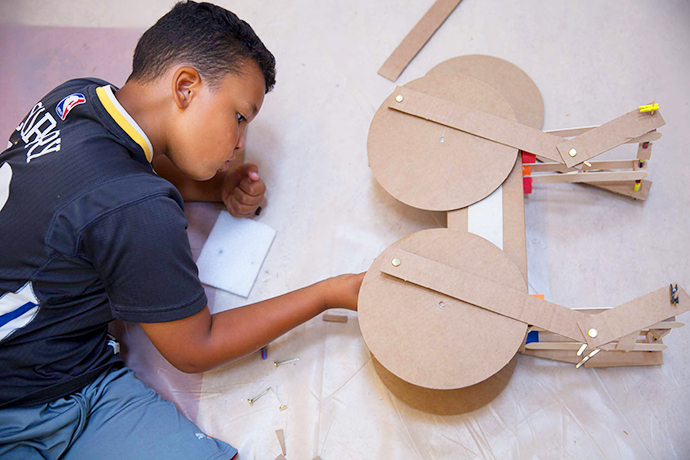Bloom’s Taxonomy is a hierarchy of critical thinking skills that figures prominently in all levels of education and in educational reform. It provides a structured model for understanding and organizing educational objectives across varying levels of learning. While well-known to educators, school administrators and academics, the taxonomy is less familiar to many who work in other industries. However, anyone interested in the way kids learn will find that it’s worth having a basic knowledge of this complex model.
The cognitive processes categorized and classified in Bloom’s Taxonomy describe what students are expected to learn and be able to do, and are therefore applicable to lesson planning and testing. They are also applicable in the home, as caretakers set chores and tasks for kids and help them grow their attentiveness and sense of responsibility.
With levels that apply across content areas, Bloom’s Taxonomy is important to learning at every grade and in every subject. Understanding Bloom’s Taxonomy can help parents support their kids as they engage in both lower and higher order thinking skills. It assists in bridging the gap between school subjects and real-life applications by developing specific valuable skills students need.
History of Bloom’s Taxonomy
Bloom’s Taxonomy forms the basis for creating structured educational plans and objectives in classrooms. The original taxonomy was developed byeducation researchers at the University of Chicago in the 1950s. Named after the committee’s chairman, Benjamin Bloom, the original document was subdivided into cognitive (thinking), affective (emotional) and psychomotor (physical/kinesthetic) domains. It is the cognitive domain that is well known and widely referred to as Bloom’s Taxonomy.
Sometimes drawn as a pyramid with the lowest-demand skills as a broad band on the bottom, the levels advance in order of complexity. From lowest order to highest, the original levels were expressed as nouns: knowledge, comprehension, application, analysis, synthesis and evaluation.
In 2001, Bloom’s colleagues and students published a revised taxonomy. The most significant change was to relabel the thinking skill levels with verbs that describe measurable outcomes. This revision of Bloom’s Taxonomy better reflects contemporary educational practices, including specific cognitive skills. In addition, synthesis was renamed “creating” and moved to the highest spot among the levels of cognitive skills.

Levels of Bloom’s Taxonomy
The levels in Bloom’s Taxonomy are distinct in their cognitive demands, requiring various student abilities.
Remember
At the lowest level of cognitive demand, kids are expected to recall, such as state names, dates, facts and events. Locating, matching and finding are sample tasks at this level of complexity, as is identifying the 5 Ws (who, what, when, where, which).
Understand
Slightly more complex than simply recalling, the understanding level requires kids to demonstrate comprehension. Typically, they would be asked to explain, classify, infer or summarize. This level involves recognizing and interpreting concepts.
Apply
This involves applying learned concepts to solve real-world problems and develop unique solutions. Using what they have learned in a new way exemplifies the application level. At this level, kids might be asked to solve, model, construct or experiment with different elements of the subject. By engaging in different types of problem-solving tasks, students become adept at applying theory practically.
Analyze
Breaking something down into steps or component parts typifies the analyzing level, as does finding evidence to support inferences or generalizations. Thinking tasks at this level include categorizing, dissecting, and differentiating. Activities might include organizing and synthesizing information from various sources.
Evaluate
At this level, the cognitive demand is pretty high. This focus on evaluation pushes students to develop critical judgment abilities. Kids might be asked to make a judgment based on a set of criteria, to prove or disprove, to justify or give an opinion. Students might also engage in classroom debates or analysis activities that enhance their evaluation skills.
Create
The greatest demand is at the creating level. Here, kids are required to put information together in a new or unique way. They might be asked to design or construct, to theorize or invent, to propose a plan or a solution. Activities might involve developing innovative projects.

Understanding Bloom’s Taxonomy
The first three levels represent lower-order thinking skills, while the upper three involve higher-order thinking, which requires a complexity of thought and more cognitive demand. This understanding helps in constructing the curriculum by aligning goals to various educational objectives.
Though presented as a hierarchy, Bloom’s Taxonomy is not meant to be a linear or sequential progression through the skills, as kids of all ages need to utilize both higher and lower order thinking skills. So, for example, while reading a novel, kids may recall story events (remembering) and explain a character’s motivation (analyzing) before writing an alternate ending for the story (creating).
Bloom’s becomes especially important in project-based learning, where the goal is for kids to engage in critical thinking and problem-solving. Today, educators use the taxonomy to ensure that appropriate cognitive demands are placed on 21st-century students.

Implementing Bloom’s Taxonomy in Teaching Practices
Following this model ensures that students traverse through different cognitive stages to meet educational goals. Educators can effectively implement Bloom’s Taxonomy by designing a curriculum that thoughtfully includes each level of the taxonomy in lesson plans. This structured method aids in developing measurable learning outcomes by concentrating on the distinct levels of Bloom’s Taxonomy. The taxonomy not only assists in organizing course materials but also provides a guide for framing questions and assessments. Teachers can begin by pinpointing the cognitive domain objectives of their course and then organizing activities that address each level to ensure students build a thorough understanding of the subject.
Supporting Kids in Higher-Order Thinking
nvolving learners in various classroom activities boosts their capability to tackle complex tasks. Parents and caregivers can support their kids in developing higher-order thinking by attending to the questions they ask them. Rather than simple yes and no questions, focus on open-ended inquiries where kids can draw upon their own life experiences. Higher-level questioning will prompt higher-order thinking in kids. By applying these, they develop higher cognitive abilities beyond foundational memories.
Help kids envision a scenario and imagine they are there, then ask them questions that require complex thinking. Here are a few question stems that could be adapted to a variety of situations:
- What would happen if…
- How is this like (blank)? How is it different?
- Can you think of another way to solve this problem?
- Does this remind you of anything/anyone you have seen/met before?
- What is most important?
- How could we prove that…?

Assessing Student Learning with Bloom’s Taxonomy
Assessment strategies aligned with Bloom’s Taxonomy stress both lower-order and higher-order thinking skills. Utilizing assessment tools that gauge specific objectives across Bloom’s levels allows teachers to evaluate student understanding and learning progression more accurately. Effective assessments might encompass varied forms such as quizzes, projects, and reflective essays, all crafted to measure the depth of student comprehension and their ability to apply, analyze, and evaluate based on mastered concepts.
Building a Range of Skills
Implementing this model across various curriculums provides a diverse form of education. Each of us uses a variety of thinking skills on a daily basis, from simple recall to more complex analysis and synthesis. The cognitive taxonomy influences how educational objectives are structured in the classroom.With a basic understanding of Bloom’s Taxonomy, parents can support kids as they develop their critical thinking and problem-solving skills. Dexterity with these skills will benefit them in school and in relationships, and someday, those same skills will help them excel in their careers.
—
To help give kids’ critical thinking and problem-solving skills a boost, check out the engaging activities and classes at Camp Galileo Anywhere.





